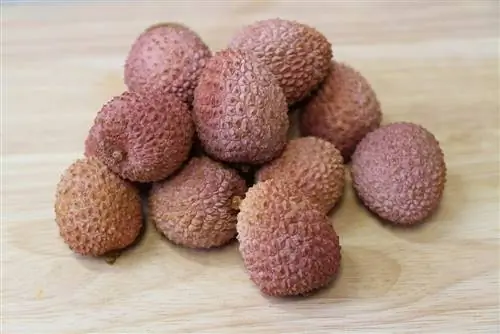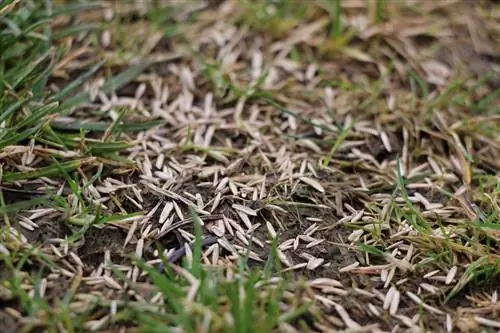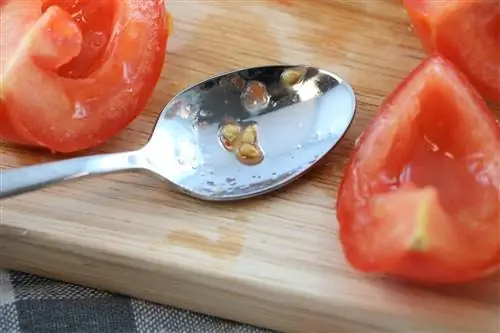- Author admin [email protected].
- Public 2023-12-17 03:39.
- Last modified 2025-01-24 12:45.
Growing a lychee tree is easy in itself - if the special features of the plant are taken into account. And this begins with the correct preparation of the seeds. In addition, pulling the lychee from the fruit stone requires some patience because the shoots grow slowly and even take a break in growth. Anyone interested can find out what’s important here.
Cores
Under the rough skin and white flesh there is a brown, shiny and smooth core. This stone is elliptical in shape, about two centimeters long and one and a half centimeters wide.
In order for it to be used successfully to grow the lychee, it must first be freed of all pulp residue and rinsed thoroughly with lukewarm water, as any remaining residue can lead to rot during cultivation. When cleaning, care must be taken not to damage the core skin.
Tip:
Small remains of the pulp are easier to remove if they have been allowed to dry for a few hours beforehand. They can usually be easily removed with your fingers.
Let springs
In preparation for germination, the core membrane must first open. The quickest and easiest way to do this is to soak the seeds. For this purpose, they are placed in a container with lukewarm water and placed in a warm location - for example near a heater or in the sun. The water does not have to stay warm permanently, but it should not cool down completely either. After a few days, the outer shell of the kernel bursts open and the seed can be planted.
Substrate
For starters, potting soil is ideal and the easiest choice. If you want to mix the substrate yourself, you can combine one part perlite, sand, coconut fiber and high-quality garden soil. In any case, it is important that the requirements of the lychee are taken into account. These look like this in relation to the substrate:
- permeable and loose, with moderate storage capacity
- pH value below 7
- nutrient poor
- not prone to compaction
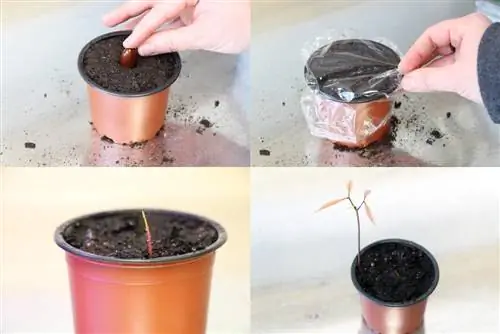
Also note that the lychee is sensitive to waterlogging and therefore appropriate drainage must be provided in the cultivation container. To be on the safe side, you can first add a drainage layer of coarse gravel to the plant pot and only then fill in the substrate.
Location
Where exactly the lychee comes from cannot be traced. It was cultivated very early on and thus spread by people. In the open field it thrives primarily in the subtropical areas of Asia. The requirements for the location can already be derived from this. This should be warm, sunny and moderately humid. The window sill is therefore ideal in a warm and bright room. In autumn and winter, a plant lamp may also be necessary.
germinating
As mentioned, the seeds can be placed in the substrate when the outer skin of the kernel has cracked. They are covered with soil in the planter about a centimeter thick and should be spaced five centimeters apart from each other. After that, the following points are important:
- The substrate must be kept moist, but should not be soaked. Moistening with a plant sprayer is ideal, although the top layer should initially appear wet. You can then spray if necessary to keep the soil slightly moist.
- To maintain warmth and moisture, you can cover it with a plastic film, a pane of glass or place it in an indoor greenhouse. To prevent mold from forming, the cover should be removed for a short period of time every day.
- Since the lychee is initially very sensitive, the temperature should be checked regularly and remain as stable as possible. Around 20°C is optimal, less than 18°C should not be for germination.
Tip:
Patient is required during germination. You have to expect at least four weeks until the first visible shoots.
Pouring
During germination and even when the first shoots are visible, spraying the substrate with water is preferable to watering. In this way, there is no risk of waterlogging and the soil can be moistened more evenly. In addition, there is no risk that the lychee seeds will be washed away when watered. In addition, the special characteristics of the lychee must be taken into account when watering. One of these is not to use cold water. It should be at room temperature so as not to damage the roots. The lychee is also sensitive to lime, which is why only soft water should be used. For example, rainwater, low-lime, filtered or stale tap water is suitable.
Tip:
If you don't know the hardness of your own tap water, you can ask the responsible waterworks or determine the limescale content using test strips.
Fertilize
In the beginning, the lychee is supplied by the nutrients contained in the core, so it does not require any additional fertilization. This only becomes necessary about a year after sprouting. Even then, you don't have to use fertilizer straight away; changing the substrate is usually enough to get you started. From the second year onwards, fertilization can be carried out from spring to late summer. A liquid fruit fertilizer has proven successful.

It is important to keep the dosage low. A quarter of the amount recommended by the manufacturer is administered. Since the lychee grows very slowly, one dose every two to four weeks is sufficient. Fertilization should be stopped in September, even if the plant spends the winter indoors frost-free.
Repotting
When the first pair of leaves appear on the lychee, it can be repotted for the first time. This measure is particularly recommended if several seeds have been grown in one cultivation container. The following points are important when repotting or changing the substrate:
- the core must be converted as it serves as a nutrient reserve
- The roots should be treated very carefully as they are sensitive and quickly damaged
- Litchi seeds that are moldy or have not sprouted after eight weeks should be removed
The subsequent substrate should be loose and have a pH value of 7, but may be slightly richer in nutrients. This can be achieved by using a larger amount of garden or compost soil. The components of the mixture already mentioned should also be used to loosen it up.
Repotting can be done once a year to provide the lychee with new nutrients and reduce the risk of disease.
Freeland
The lychee is sensitive, especially at the beginning, but after sprouting it can spend the summer outdoors. Of course, it should not be planted, but should continue to be cultivated in a pot in a planter. It is also important that the lychee slowly gets used to direct sunshine. It should therefore initially be placed in a bright location without direct sun and gradually moved to a sunnier spot. If late frosts are to be expected or the temperatures fall below 18 °C, the plant must be brought back indoors.
Wintering
Due to its subtropical origin, the lychee does not tolerate frost. It can therefore only be overwintered indoors. Here it should be bright and cool, but not cold. Overwintering in a warm room is also possible, but the lychee usually thrives better if it spends a season between 15 and 18 °C.
Light
A crucial factor in growing lychee is light. In the local latitudes, even on the south side, this is usually not enough to promote he althy growth. The young plants often form so-called “emergency shoots”, which are very long and weak and die quickly. The only solution to this is usually to let a plant lamp shine on the lychee outside of summer or in darker locations. There is a corresponding selection available from specialist retailers.
Tip:
If you connect the plant lamp to a timer, you can automatically ensure the lighting duration and reduce the effort involved in cultivating the lychee tree.
Growth
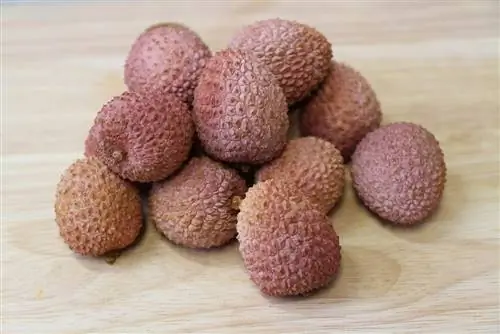
In subtropical open spaces, lychee trees reach a height of ten meters or more. However, they grow very slowly and even take a break in growth in the second and third year after germination. This makes many believe that the attempt at breeding lychee has failed, but patience is usually just required. However, coordinated care as well as sufficient light and nutrients can help stimulate growth.
However, it must also be noted that the lychee tree will no longer fit on the windowsill as it gets older. A location in the winter garden is ideal. In the long run, the plant will only fit in a suitable location with a cutting, because it cannot remain outdoors during the winter.
Fruits
If the lychee is successfully grown, flowers can be expected to form from around the fifth month. These must be pollinated by insects so that fruit can develop. The lychee should be placed outdoors by the time it blooms at the latest.
Harvest
The lychee fruits are harvested when the peel has a pinkish-reddish color. If they turn brown, the flesh is already dry. However, the lychees should not be harvested too early because they do not ripen. If the stems are still green, they should still remain on the tree.
Typical care errors, diseases and pests
The lychee is spared from diseases and pests, but care errors can occur. Particularly common are:
- lack of watering and humidity
- calcareous substrate or water
- Waterlogging
- too cold location
- too little light
With an adapted watering behavior and occasional spraying with soft water as well as a slightly acidic substrate and good drainage, many risks can be eliminated. A warm and bright location and the use of a plant lamp solve the remaining problems. If these conditions are met, the lychee will continue to grow slowly - but surely.




